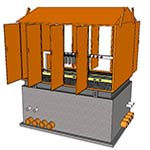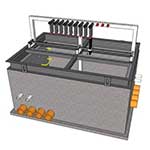Traditional Termination Pits
During the installation of high voltage electrical cables, cable runs are limited by the length of the cable drum (e.g. 500m), maximum pulling tension, change of direction and more. For longer runs, cables need to be joined via an electrical termination. These terminations can be a point of failure and should be accessible for inspection. Terminations, however, are typically outlived by their cables by multiple lifetimes, as well as being the most likely point of failure. Therefore, high voltage electrical termination installations require proper design and construction.
Traditional cable terminations are done using a termination pit. This is normally a solid enclosure with a removable lid, constructed below ground level and in line with the cable runs. The simplicity of a traditional termination pit means that they are usually cheaper to construct, thereby reducing capital expenditure. However, they are typically accessed infrequently and are therefore generally small, meaning that manual handling can be difficult for maintenance personnel. Additionally, given its physical characteristics, a termination pit is usually classed as a confined space. Over time, these factors lead to increased risk to personnel safety, increased maintenance costs through labour and manual handling and other physical drawbacks, like possible flooding. Therefore, there are multiple downsides to traditional termination pits.
An alternative to cable terminatation pits
The solution to overcome the major drawbacks of traditional electrical termination pits is bringing the pit above ground. By creating an enclosure above ground level, as shown in the gallery below, asset owners can:
- Reduce overall costs
- Reduced civil works – no pit required
- Reduce termination time and cost
- Construction site time is quicker (labour costs reduced)
- Reduce risk by preventing certain environmental hazards (e.g. flooding) from occurring
- Improved Safety Outcomes
- Removing the need for confined space entry
- Pinch points eliminated as no heavy pit lids
- Inspections more convenient, no ladders, can be done in open doors
- Lower total cost of ownership as no lifting equipment required for inspection
- Can be combined with a cable pit to coil service loops in both sides of cable allowing for re-termination should a failure occur
What options are there in above-ground termination enclosures design?
The primary variable in designing the enclosure is the number of cables to be terminated within the enclosure. This affects the overall size. If being installed above an existing pit, a removable grid mesh floor can be installed so that the new terminations can be done without interfering with legacy equipment.
Quality design elements
We utilise IEC 60502-4 bolted tee connectors, a tried and tested technology for high voltage electrical terminations. These connectors allow closer terminations than other solutions, resulting in less risk of creating an ionised atmosphere and less risk of general failure over time. Additionally, they are easier to disconnect and reconnect, allow greater servicing ability and improve safety. Furthermore, significant on-site experience leads to selection and construction processes that are practical and forward-thinking.
Disadvantages of Above-Ground Termination Enclosures
The main disadvantage would be risk of mechanical damage due to a vehicle interaction. If a termination pit is near a roadway we recommend bollards to prevent damage.
A termination enclosure that delivers value
Teck Global works with final asset owners to develop suitable above-ground termination enclosures, a product that delivers long term safety and cost benefits. We encourage anyone with electrical termination requirements to contact us to see how we might help.



